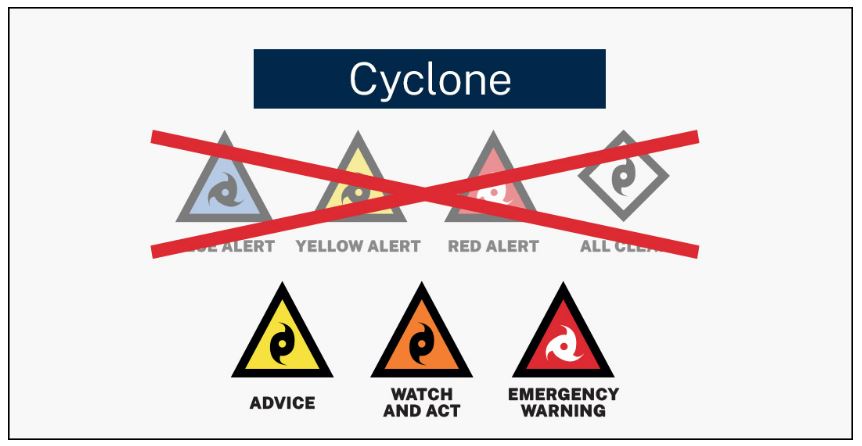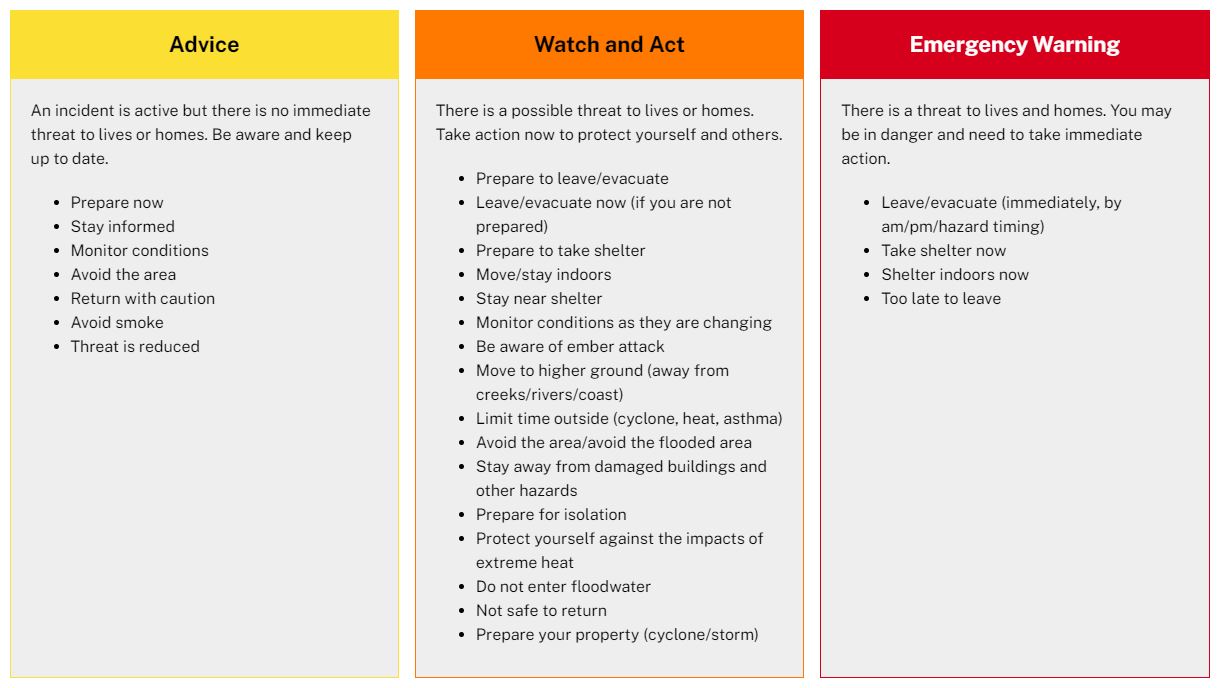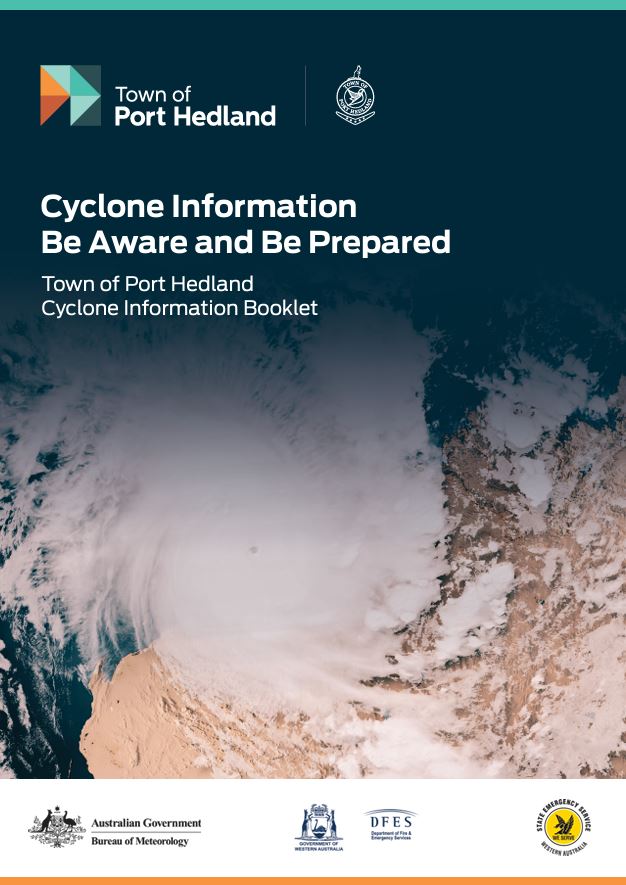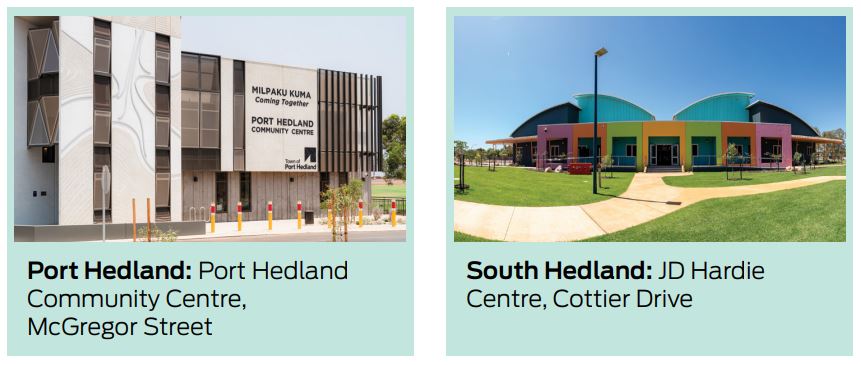Cyclones
The Risk
The Pilbara coast between Broome and Port Hedland is considered the most cyclone prone in Australia.
It is vital residents within the Town of Port Hedland know the risk and prepare for the cyclone season, which runs from 1 November until 30 April each year.
If a cyclone approaches Port Hedland, its progress can be monitored by accessing the Town’s Disaster Dashboard. The Town’s Facebook page will issue up-to-date alerts on any developments before, during and after a cyclone.
During A Cyclone
DFES issues alerts when a cyclone is approaching. The three stages of alerts are: Advice, Watch and Act and Emergency Warning.

As of 15 July 2024, Western Australia has adopted the Australian Warning System (AWS) for bushfire, cyclone, flood and storm warnings.
The AWS is a national approach to emergency information that aims to deliver consistent warnings to Australian communities, so people know what they need to do to stay safe in an emergency, no matter where they are.
Consistent warning levels, colours and hazard icons supported by a clear and concise action statement will make warnings easier to understand.

Cyclone Information - Be Aware and Be Prepared booklet

Notable Port Hedland cyclones
Tropical Cyclone Joan (December, 1975):
Tropical Cyclone Joan remains one of the most intense tropical cyclones to affect Australia.
She was at her peak when crossing the coast 50km from Port Hedland, with wind gusts of 208km/h recorded at Port Hedland airport.
Joan caused significant property damage in Port Hedland.
Source: BOM
Severe Tropical Cyclone George (March, 2007):
Severe Tropical Cyclone George crossed the coast as a Category 5 system 50km northeast of Port Hedland.
Wind gusts of up to 275km/h, with a 10-minute mean of 194km/h, were recorded at Bedout Island, and 154km/h gusts were recorded at Port Hedland airport.
Sadly, three people lost their lives during Severe Tropical Cyclone George.
Source: BOM
Cyclone Categories
| Category |
Maximum Wind Speed (km/h) |
Typical Strongest Gust (km/h) |
Typical Effects |
| 1 |
63 - 88
|
< 125
|
Damaging winds. Negligible house damage. Damage to some crops, trees and caravans. Craft may drag moorings.
|
|
2
|
89 - 117
|
125 – 164
|
Destructive winds. Minor house damage. Significant damage to signs, trees and caravans. Heavy damage to some crops. Risk of power failure. Small craft may break moorings.
|
|
3
|
118 - 159
|
165 - 224
|
Very destructive winds. Some roof and structural damage. Some caravans destroyed. Power failures likely.
|
|
4
|
160 - 199
|
225 - 279
|
Significant roofing loss and structural damage. Many caravans destroyed and blown away. Dangerous airborne debris. Widespread power failures.
|
|
5
|
> 200
|
> 279
|
Extremely dangerous with widespread destruction.
|
Source: Bureau of Meteorology
Cyclone Preparation
One of the most important things that any individual can do is to prepare their property for the cyclone season.
Preparing your property means damage is minimised, which may contribute to the saving of both life and property.
The State Emergency Service (SES) and the Town of Port Hedland recommend that the following be undertaken prior to 1 November:
- Clear your residence or work area of unwanted materials and rubbish
- Trim trees of excess height and growth to enable them to withstand high winds.
- Clear drains of rubbish or obstructions.
- Prepare or review your Family Cyclone Plan.
- Prepare and have available your family emergency kit including adequate drinking water containers.
- Decide where best to shelter your pets.
- Organise tie down areas and obtain tie down equipment for securing caravans, boats, trailers and other large loose or bulky items.
Welfare centres

If an evacuation is required, the police or DFES/SES will advise you on what actions you will need to take.
If you need to evacuate, consider seeking refuge with a friend or colleague who lives on higher ground.
The Town of Port Hedland has identified the following buildings as welfare centres for people who do not have adequate accommodation during a cyclone:
- Milpaku Kuma/Port Hedland Community Centre - McGrgeor Street, Port Hedland
- JD Hardie Youth and Community Hub - Cottier Drive, South Hedland
Welfare centres will only be opened on the advice of DFES/SES and manned by the Department of Communities.
For further information regarding welfare centres, please contact the Department of Communities on (08) 9160 2800.
After A Cyclone
Be aware that there may be debris or other hazards still present even after the all-clear has been given by authorities.
Flood waters could clog storm water systems, and residents need to be aware of the dangers or playing in or around storm drains, ditches, ravines or culverts as it is very easy to be washed away by fast-moving water.
Put some thought into what you and your family might do following a cyclone. Loved ones may need to shelter in different places (at work, for instance), normal communications may be difficult and power could be cut.
It is important to keep emergency contact numbers on hand, and knowing the basics of first-aid is also encouraged.